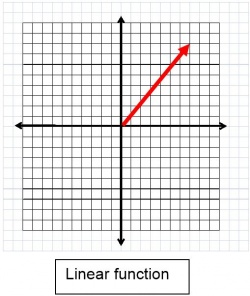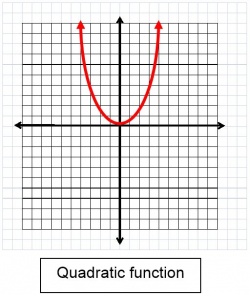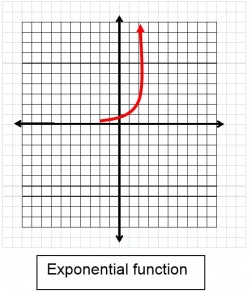Functions Content Module
BACK TO Content Modules
Contents |
Plot the Course
The Rationale
Remember the old saying "a picture is worth a thousand words?" The ability to look a graph and interpret its meaning is an integral skill in both everyday life and almost any profession. For example, when you receive your electricity bill, a graph is often included so that the customer can see what months they used the most electricity at a quick glance.
Module Goal
The goal of this module is to provide detailed instruction on the more difficult concepts of functions (i.e., linear, and quadratic) to teachers of students with disabilities at the middle and high school level. This module promotes a mathematical understanding of these concepts so that a teacher can begin to plan how to teach the concepts to students. Additionally, this module will provide instructors with potential adaptations and modifications to consider when designing materials and instruction for students with severe disabilities.
Module Objectives
After viewing the content module, teachers will:
- Identify independent and dependent variables
- Identify a linear function
- Identify a quadratic function
- Discriminate between functions and non-functions when provided graphs
Time for Take Off
Understanding the vocabulary used within functions is important for both teachers and students in planning and implementing math lessons. As a teacher, knowing and using the mathematical terms not only ensures your instruction stays true to the math content, but will also help with collaborating with other math teachers or content experts. When choosing which vocabulary to teach, it is most important that the teacher selects the most salient, important, or most frequently used vocabulary for each lesson.
Below you will find a list of vocabulary included within this module. It may or may not be necessary to provide instruction for all terms as students may have learned them previously. Functions are mostly covered in middle school so vocabulary for this content module has been combined. If you are a high school teacher and are not confident your students know some of these vocabulary terms, you may want to review and teach some unknown terms in the focus and review part of your lesson plan. While providing vocabulary instruction, you may consider including pictures or objects to make the instruction more concrete for students with disabilities (See Ideas to support vocabulary learning below).
Vocabulary
- Variable - a term that includes a letter that represents a value (e.g., in the equation y = 2x + 4, 2x is the variable).
- Constant - a fixed value (e.g., in the equation y = 2x + 4, 4 is the constant)
- Independent variable - what is being manipulated in the situation. For example, when measuring a child's height as they get older, the aging process is the independent variable (age is what is being changed).
- Dependent variable - what is changed as a result of manipulating the independent variable. For example, when measuring a child's height as they get older, their height is the dependent variable (it changes as a result of the independent variable).
- Function - mathematical operations demonstrating the relationship between the input and output of an expression.
- Linear function - represented by an equation in the form of y = mx + b; when graphed the coordinates provided will form a straight line.
- Quadratic function - represented by the an equation in the form of y = mx2 + bx + c; when graphed the coordinates provided will form a U-shape.
- Exponential function - represented by an equation in the form of y = mx, where a is a positive number not 1; a common exponential function is the growth of some organism (including humans).
Ideas to Support Vocabulary Learning
- Teach students to discriminate between linear, quadratic, and exponential functions based on the appearance of graphs.
Floating on Air
Before you can begin teaching functions, you need a deep understanding of these mathematical concepts. Some of these concepts may be familiar to you. Below is a list of skills that should be covered at each grade level. For concepts that you need more information about, please view the accompanying PowerPoint presentations that will walk you through an example as well as make some suggestions for instruction.
Middle and High School
In middle and high school skills include:
- 6.PRF.2a4 Analyze the relationship between the dependent and independent variables using graphs and tables, and relate these to the equation
- 8.PRF.2c1 Given two graphs, describe the function as linear and not linear
- 8.PRF.2e1 Distinguish between functions and non-functions, using equations, graphs or tables
- H.PRF.2c1 Make predictions based on a given model (for example, a weather model, data for athletes over years)
| NOTE: All PowerPoint presentations begin with the same “What is a function” slides for review. |
Great! Now that you have viewed the PowerPoint presentation most useful to you, the next section will provide some ideas to consider when planning for Universal Design for Learning.
Sharing the Sky
UNIVERSAL DESIGN FOR LEARNING
| Some examples of options for teaching functions to students who may present instructional challenges due to: | ||||
| Visual Impairment or Deaf/Blind | Physical Impairment: Little/No Hand Use | Lacks Basic Numeracy Concepts | Motivational/Attention Issues | |
| Representation | Add texture to graphs and axis so students can feel the shape of the function's input and output. | Manipulate graphing software using assistive technology (switches, laser pointer). | Always pair equation with its graphic representation. | Enter ordered pairs into graphing software instead of drawing by hand. |
| Expression | Students scan textured graphs to discriminate between linear, exponential, and quadratic functions; Student states answer or scans raised numbers to select correct answer; use voice output devices for student to select the correct answer. | Focus on students ability to discriminate between functions based on the graph versus computation; use a switch to indicate correct answers; use an eye gaze board to select answer; phrase questions so that they require a "yes/no" response, these can easily be answered using an eye gaze, head turn, two switches, etc. | Enter equations into graphing calculators; use graphing functions to find x and y intercepts or specific ordered pairs; Focus on students ability to discriminate between functions based on the graph versus computation. | Utilize all the technological possibilities when studying functions (e.g., graphing calculators, talking calculators, free online computer software). |
| Engagement | Create personally-relevant stories to accompany the graph (e.g., for an exponential function develop a story about their own growth from birth to school age). | Use bright colors to call attention to salient feature of the graph (e.g., the shape, where it cross an axis); pair student with another student without a physical impairment and have them work together to create fraction and decimal representations. | Use a graphing calculator or free online graphing software that allows student to enter an equation as it appear and creates the graph for the student. | Utilize graphing software on computer or tablet PCs; pair with another student to complete problems in pairs. |
Prepare for Landing
Below you will find ideas for linking functions to real-world applications, the college and career readiness skills addressed by teaching these concepts, module assessments for teachers, sample general education lesson plans incorporating universal design for learning framework, blog for teachers to share their ideas, and a place to upload and share lesson plans from teachers who completed this module. One way to help assist in a special educator's development within this curricular area is through collaboration with other teachers in your building. Some activities with real world connection include:
- Anything that grows (e.g., bacteria, plants, students)
- Focus on using the mathematic tools (e.g., graphing calculators), these skills can be possibly generalized into data entry or operating a cash register
In addition to the real-world applications of these concepts, skills taught within this content module also promote the following college and career readiness skills.
Communicative competence: Students will increase their vocabulary to include concepts related to "growth", "output", "relation" or "input" In addition, they will be learning concepts such as "exponent".
Fluency in reading, writing, and math Students will have an opportunity to increase their numeracy and sight word fluency while participating in problem solving related to "functions" such as number recognition, counting, and interpreting a graph.
Age appropriate social skills Students will engage in peer groups to solve problems related to "functions" that will provide practice on increasing reciprocal communication and age appropriate social interactions.
Independent work behaviors By working with real life problems related to "functions" students will improve work behaviors that could lead to employment such as marketing or any job that has to analyze sales rates, stock clerks, order fillers, retail cashier, and laboratory assistant based professions. When providing opportunities for real life problems leave some materials out and prompt/teach the students to determine who they should ask and what they should ask for to be able to solve the problem.
Skills in accessing support systems At times, students will need to ask for assistance to complete activities related to "functions" which will give them practice in accessing supports. Students will gain practice asking for tools such as graphing calculators or other manipulatives. They can ask a peer to complete the physical movements of the tasks they are not about to do themselves. Be sure to teach students to ask versus having items or supports automatically given to them.
In addition to collaborating with other educational professionals in your building, the following list of resources may also help provide special educators with ideas for activities or support a more thorough understanding of the mathematical concepts presented in this content module.
Additional Resources
- http://itools.subhashbose.com/grapher/ - This website allows you to simply input x and y-coordinates and it will graph the function for you
- http://www.ncpublicschools.org/acre/standards/common-core-tools/ - This website provides an "unpacking document" for the Mathematics Common Core Standards that helps teachers identify what is most important and the essential skills for each standard.
- http://www.shodor.org/interactivate/lessons/ - Website include fully developed and interactive general education lesson plans for a variety of math topics including functions.
- http://www.mathforum.com/ - Website specifically for teachers which provides a variety of ideas and activities to use in your classroom.
- www.teachertube.com - Youtube for teachers! Simply search for your content area and this websites provides a variety of videos including videos of math experts working through math problems step by step (free registration required).
- www.ksde.org - This website provides a webinar about how to adapt materials for students who have visual impairments.
Module Assessments
Sample General Education lesson plans
Adapt the following general education lesson plan; adapt, and upload. These lesson plans may be shared with higher education professionals developing strategies to provide meaningful academic instruction in mathematics to students with severe disabilities.








